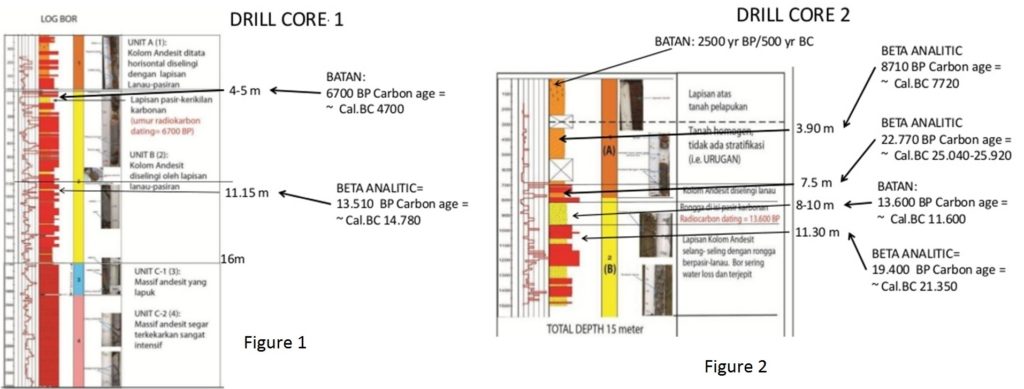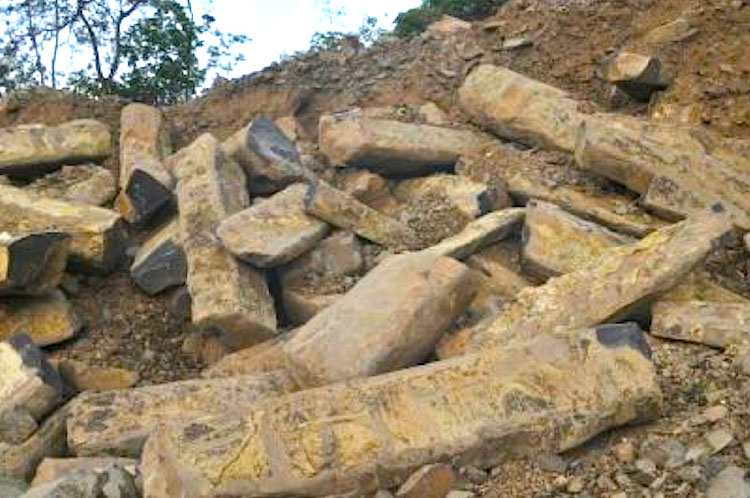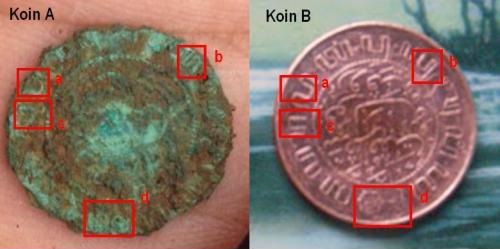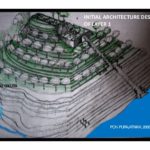 Is Gunung Padang in West Java a stunning mega-monument built millennia earlier than mainstream archaeologists would have you believe was possible? Is it the smoking gun that at last proves the existence of lost Atlantis? Or is it…a hill?
Is Gunung Padang in West Java a stunning mega-monument built millennia earlier than mainstream archaeologists would have you believe was possible? Is it the smoking gun that at last proves the existence of lost Atlantis? Or is it…a hill?
Part 2 of this series examined one of the two chief lines of evidence used to support the Atlantean claims of the chief researcher, seismologist Danny Hilman Natawidjaja: the andesite columns which Natawidjaja believes could only have reached their present configuration by non-natural means. In fact, it is perfectly possible (and far more likely) that the bulk of the andesite columns are an in situ natural geological formation, and only the ruins on the summit are manmade. On that basis alone, the Atlantean claims are dubious. But what about the other chief line of evidence: the radiocarbon dates and associated archaeological materials that are said to support a megalithic building history going back as far as 20,000 BC, the putative era of the lost supercivilization of Atlantis?
The Radiocarbon Dates
First, a word on radiocarbon dates in general. There is an old saying in the archaeological trade: one date is no date. Until a C14 date is crosschecked by other lines of evidence or is backed up by a suite of other carbon dates, it is not a valid peg on which to hang an absolute chronology. There are too many factors that can skew a single date: contamination, intrusion, laboratory error, and the probabilistic nature of the method itself. Second, it is critical to know the behavioural relevance of what is being sampled. Say a fragment of wood is found in the ruins of a Roman villa. Was that piece of wood freshly cut, or centuries old when it entered the archaeological record? Was it discarded while the villa was in use, or tossed into rubbish pit dug centuries after the structure was abandoned? Is its presence, indeed, a result of human activity, or natural processes? Is it part of a primary or secondary deposit? The lesson is that radiocarbon dates are not magic, and have important caveats around their interpretation.
Here is how Graham Hancock summarizes the radiocarbon dates from Gunung Padang, both online and in his 2015 book, Magicians of the Gods (p.36):
First the drill cores contained evidence – fragments of columnar basalt – that man-made megalithic structures lay far beneath the surface. Secondly the organic materials brought up in the drill cores began to yield older and older dates – 3,000 BC to 5,000 BC, then 9,600 BC as the drills bit deeper, then around 11,000 BC, then, 15,000 BC and finally at depths of 90 feet and more an astonishing sequence of dates of 20,000 BC to 22,000 BC and earlier.
Other alternos pretty much follow this party line, and Natawidjaja does nothing to dispel the impression in informal interviews and presentations. However, as far as I can determine, this claimed historical reconstruction, spanning up to 25,000 years, is based on exactly seven carbon dates, derived from samples from two drill cores—the deepest at a depth of 11.3m. Table 1 shows all the dates in order of depth; see also Figures 1 and 2.
Comments on the Carbon Dates.
Hancock’s claim, which Natawidjaja has allowed to stand, is misleading in the extreme. There is no “astonishing sequence of dates of 20,000 BC to 22,000 BC and earlier.” Of the two dates older than 20K, the one at 7.5m (25,040 BC) looks impossibly iffy, as it overlies material dated to 11,600 BC from the same drill core. Normal procedure would be to discard it as anomalous. The other (21,350 BC) was taken from 11.3 m (37’), which is a very far cry from Hancock’s 90’. Note also that it was apparently separated by all of six inches in depth from material dated to 14,780 BC in the other core. This is not impossible, but it raises a red flag.
Another large red flag is raised by comparing the raw and calibrated dates from the two labs. The BETA calibrations look fine. The raw and calibrated BATAN dates, however, differ in all cases by exactly 2000 years, which is a highly unlikely coincidence—indeed, it looks more like a quick’n’dirty approximate conversion from BP to BC, and not a calibration at all. If so, this would be somewhat deceptive.
Further red flags are raised by the mixture of samples from two different cores, and two different labs. Core 1 was drilled from Terrace 3, but I was unable to ascertain where Core 2 was drilled; therefore, it is hard to know how the depths of the samples are correlated. There is more confusion trying to correlate Natawidjaja’s “units” with the cultural and stratigraphic levels mentioned elsewhere, as the usage appears to be inconsistent. One hopes this confusion will be cleared up if and when Natawidjaja publishes a formal report, and also that he will provide the mandatory error estimates and full designations for his dates. Until then, this meagre sequence of dates can be regarded as no more than suggestive, just a step up from “one date is no date” level. It certainly cannot support the weight of his or Hancock’s grand claims.
Behavioural Relevance Issues
It is very difficult to sort out exactly what was being sampled for carbon dating—and therefore, to make even a wild guess at the samples’ behavioural relevance. Sometimes, the samples are described as organic inclusions in the sand or clay between layers of andesite in the drill core, as in this quote from a 2015 presentation (google translation edited for clarity):
For example in the case of Mount Padang, the artificial rock layers underground are estimated at about 7000 years BP (= 5000 years BC) based on the age of the carbon contained in the soil between the stones of the columns or layers of soil that became the foundation; This means that we assume that the soil was brought in by the men who built the site from the ground around the site, and contained the bodies of animals and plants that lived at that time or throughout the time of the construction of Layer 2 sites.
Of course this assumption may not be appropriate if the soil and sand used to make the site were taken from an older layer of soil/sand. Another thing that also needs to be taken into account is the possibility of mixing or contamination with younger or older carbon, due to natural secondary processes. In short, carbon dating is not an easy job…
Natawidjaja’s second paragraph takes the words right out of my mouth. And also, effectively, blows him out of the water. Natawidjaja holds that much of the soil on the summit of Gunung Padang was carried in from elsewhere as fill; if that were so, he would have no business assuming any incidental organic materials in the matrix are unmixed, uncontaminated, or have any behavioural relevance to his hypothetical cultures.
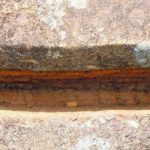 However, other reports from Gunung Padang claim the C14 samples are taken from an artificial cement or mortar found between the andesite columns in the drill cores. If this were so, the mortar would indeed be relevant. It is described by Andang Bachtiar, another geologist on Natawidjaja’s team whose expertise is mainly oilpatch-based, as an orange material composed of “45% iron minerals, 41% silica minerals….14 % clay minerals, and also carbon,” thin in the upper levels, and up to two inches thick in the levels approaching the bottom of the presumed cultural horizon. He takes the high iron content as evidence not only that it is artificial (he
However, other reports from Gunung Padang claim the C14 samples are taken from an artificial cement or mortar found between the andesite columns in the drill cores. If this were so, the mortar would indeed be relevant. It is described by Andang Bachtiar, another geologist on Natawidjaja’s team whose expertise is mainly oilpatch-based, as an orange material composed of “45% iron minerals, 41% silica minerals….14 % clay minerals, and also carbon,” thin in the upper levels, and up to two inches thick in the levels approaching the bottom of the presumed cultural horizon. He takes the high iron content as evidence not only that it is artificial (he 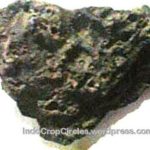 claims that natural iron ore contains no more than 5% iron), but that it indicates the existence of an early metallurgical technology capable of treating iron ore at high temperatures. He backs this up with what he claims is a chunk of clinker from a metal-working furnace, which he dates prior to 11,500 BC.
claims that natural iron ore contains no more than 5% iron), but that it indicates the existence of an early metallurgical technology capable of treating iron ore at high temperatures. He backs this up with what he claims is a chunk of clinker from a metal-working furnace, which he dates prior to 11,500 BC.
On the other hand, other geologists (including vulcanologists) who have examined the so-called mortar have no hesitation in describing it as natural. Indeed, the terraces at Gunung Padang are thick with andesite column fragments covered with iron-oxide-rich orange weathering rinds, and weathering of andesite does tend to concentrate oxidized iron and silica minerals. The few images of the “mortar” I could find look like a combination of weathering rinds and silty clays washed into the interstices among the columns. The single “clinker” looks suspiciously like a chunk of vesicular basalt/andesite, which would not be out of place on an extinct volcano. On the whole, I am dubious of both the “mortar” and the metal-working technology, and am bothered by the inconsistent accounts of where the radiocarbon samples came from.
The Ancient Amulet
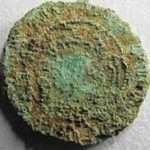 Further reason to doubt the integrity of the radiocarbon sequence comes, ironically, from one of Gunung Padang’s crown jewels. This is an artifact described as a metal coin or amulet, 1.7 cm in diameter, apparently brought up with water from the borehole while the team was drilling at about 11m in depth. According to their dating of that level, the item should be about 12,000 years old, but they decided it came from 4m down, and should thus be dated to around 5200 BC.
Further reason to doubt the integrity of the radiocarbon sequence comes, ironically, from one of Gunung Padang’s crown jewels. This is an artifact described as a metal coin or amulet, 1.7 cm in diameter, apparently brought up with water from the borehole while the team was drilling at about 11m in depth. According to their dating of that level, the item should be about 12,000 years old, but they decided it came from 4m down, and should thus be dated to around 5200 BC.
The artifact generated much excitement. As a copper alloy fusing lead, iron, and nickel, it was further evidence of the high technology of the mysterious pyramid-builders. The team decided it was an amulet, rather than a coin, and speculated on the central motif: Mayan, perhaps, or a traditional Javanese Semar puppet character, a primeval Sunda Wiwitan symbol, a kingly portrait wearing a helmet. The decoration around the edge was likened to gawangan, rectilinear wooden frames, surrounding a circle of 84 tiny raised dots.
Alas, when a photo of one face of the artifact was released, other archaeologists and numismatists swung into action. A more-than-credible comparison was made with a certain Netherlands East Indies coin, specifically the bronze half-cent piece. The diameter is right. The circle of 84 raised dots checks out. The “gawangan” and central motif are inscriptions in Indonesian and Arabic scripts, respectively. The date? This coin was struck between 1914 and 1945. Its presence in deposits which, according to Natawidjaja and Co, are 7000+ years old, strongly suggests that something is rotten in the state of Gunung Padang’s radiocarbon dates.


